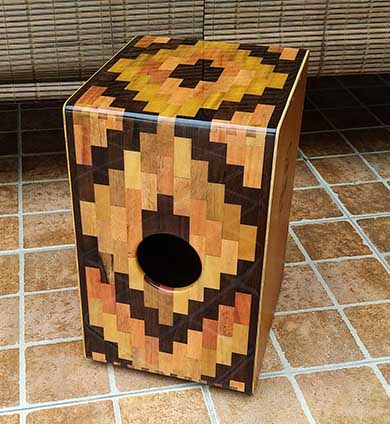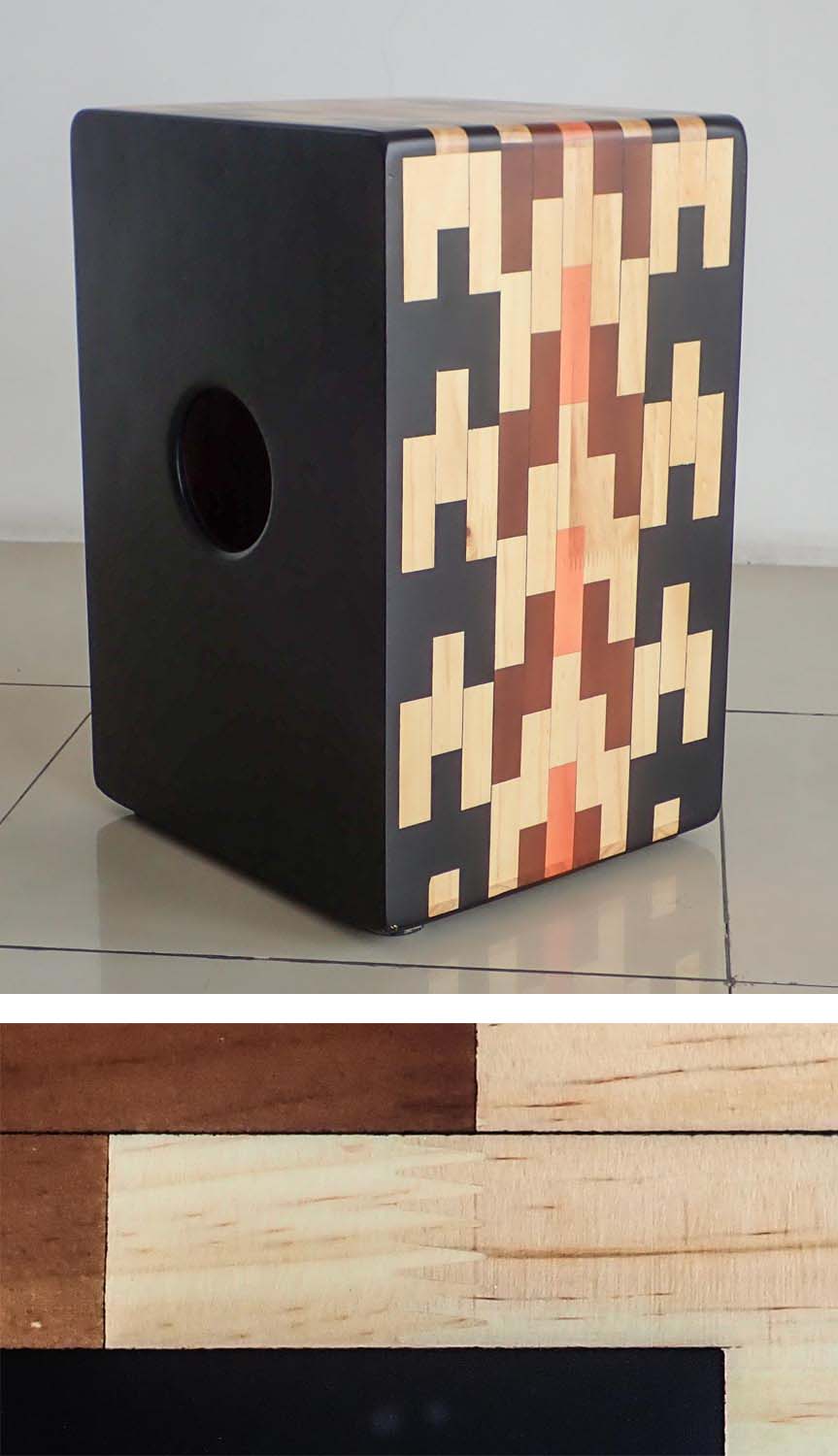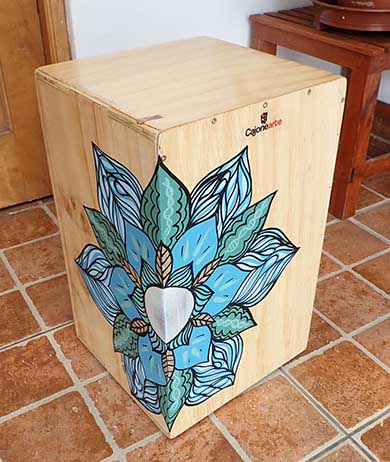The Best Wood for a Cajon Drum
I've answered a couple of Facebook posts about wood for cajon construction. Below is my updated answer. I'll keep updating it as I have more insight and information.
What's the best wood to use to make a cajon? There are three considerations: the cajon box, the back panel and the tapa (which is the playing surface).
Wood for the Cajon Box: Top, Sides and Bottom
Many artisanal cajon builders around the world make cajons from locally sourced, solid hardwood. Many builders in Europe prefer Baltic birch plywood. Cajon makers in Asia use plywood and solid wood from tropical hardwoods. Cajon businesses in South America often use local tropical hardwood, or locally available plywood. In the USA I have made great sounding cajons from Doug-fir based cabinet grade plywood and birch cabinet grade plywood. The point of these examples is: There is no magic 'best' wood for a cajon. However, here are some guidelines:
Solid Wood Cajon Boxes
Cajon builders generally recommend harder, denser solid hardwood - wenge, padouk, walnut, oak, maple etc. However, it's not a hard and fast rule, I've successfully used Sitka spruce, western red cedar and redwood, all considered tone woods. Darkwood Cajon in Canada uses Doug-fir, Day Drums in Wisconsin uses poplar successfully. JA Cajon in the Philippines use narra tropical hardwood. Arc Cajon in Australia uses spottedgum. Skull Percusion in Argentina uses recycled hardwoods from floors and furniture. These are just a few examples to show that there are many options. Most solid wood cajons are made from several to many smaller pieces edge-glued together to make a composite panel, see the photo of the ATempo and VP Percussion cajons to the right. Commercially available solid wood 'finger joint edged glued panels' are also a reasonable option for a cajon.
When constructing solid wood panels from scratch be especially careful to ensure the wood is thoroughly dried. The larger the composite pieces the greater the chance of splitting and joint failure as the cajon dries out. For larger pieces, edge joint reinforcement using splines or biscuits will help reduce warping induced edge failures. Recycled hardwood is an excellent option, it should be stable and reduces the carbon footprint of your build. Solid wood thickness of 9/16 inch (~15 mm) thick or thicker is good, but this will depend on the strength of the solid wood and your joints.
Plywood Cajon Boxes
Many cajon builders recommend hardwood plywood with more plies and without air spaces. Marine plywood, often from Indonesia, is available in coastal areas around the world and is dense with many plies, but is often expensive. In Europe multi-ply Baltic birch plywood is readily available and makes excellent cajons. My recommendation is to use locally made plywood or locally available plywood, the harder and denser, the better. The nicer the finished side of the plywood the better. Cabinet grade plywood probably produces a better looking and sounding cajon than construction grade plywood. Your choice of wood will probably be influenced by what is available locally and how much you are willing to spend.
Plywood about 1/2 inch or 12 mm thick will make a good box. Thinner, 3/8 in or 9 mm may also work well but the box may require corner bracing. Thicker, 5/8" to 3/4 inch (16 to 18 mm) will make a strong box that might not need corner bracing but will be heavier. You should consider the overall strength of the plywood when choosing thickness - multi-ply hardwood plywood will be stronger than 5 ply cabinet grade plywood.
Other Panel Materials
MDF, OSB and other composite panel materials can be used to make cajons. MDF is often used for speaker cabinets because it is sonically neutral, it doesn't change the sound emanating from the speakers. This is actually a negative in cajon construction. Many MDF cajons seem to lack sonic personality. The only advantage is cost, these panels are often cheaper than plywood. Same with OSB, if you happen to have some OSB scraps you could make a cajon from it, but it won't be the best sounding or looking cajon on the block.
TL;DR: If it is available, affordable and if you have the time and tools to work with it, dense, solid hardwood will make an awesome cajon. If you use plywood, try for hardwood plywood with more plies and fewer air spaces. Marine plywood, Baltic birch plywood or cabinet grade plywood should produce a nicer looking, better sounding cajon than construction grade plywood. Recommended thickness would be between 9mm, 12mm and 18mm (3/8 inch, 1/2 inch to 3/4 inch).
Wood for the Cajon Back Panel
The back panels of many cajons made in Peru are often the same material as the sides, with the same thickness as the side panels. Whereas many commercial cajon manufacturers around the world use thinner wood or thinner plywood, sometimes slightly less than 5 mm thick. Thin backs may give the cajon a bit more resonance. For beginning cajon makers I would suggest using the same wood you use for the sides. It will make a heavier cajon but should have good sound. If you are concerned with the weight of the final product or want to try for a bit more resonance, try a thinner back. I use polycarbonte on my cajon backs to maximize the resonance. Some solid wood cajons are hybrids with solid wood sides and plywood backs. Cajon makers often recommend 3/8 inch (9 mm) plywood for the back.
Wood for a Cajon Tapa
Most cajón builders use plywood for the tapa, 2.5 to 3mm thick. 4mm is sometimes recommended but I think that's a bit thick unless the box is bigger than usual. 5-ply hardwood plywood is often recommended but I've made great sounding tapas from 3-ply plywood. Again I would look to see what is available locally. 3mm, 3-ply plywood is sometimes available in local hardwood stores, but you may have to look at specialty hardware stores and not national chains. Many cajon makers have recycled old hollow doors using the 'door skin' as the tapa.
Plywoods suitable for a cajon tapa include:
A. Tropical hardwood plywood
Many commercially made cajons available in music stores around the world use tropical hardwood plywood for the tapa. Tapas from tropical hardwoods are generally very flexible and finish nicely. Because there are many species and every country has different harvest practices there are considerable differences between these products. Best to look for 'marine grade', it will be strong with durable glues. There is also the issue of sustainability and forestry practices which may factor into your decision. Local builders who live in coastal areas around the world should be able to find 3 mm tropical marine hardwood plywood at any hardware store catering to boat repair. Asking at the local marina should point you in the right direction. Tapas from tropical hardwood plywood are very flexible but they won't be as strong as Baltic brich or some other plywoods. I personally find I prefer the bass tones from tropical hardwood tapas but the high tones are less distinctive. Because the tropical hardwood tapas seem to flex more, they may produce more rattle from a snare-wire configuration.
B. Baltic birch hardwood plywood
Baltic birch is the favorite tapa material for many cajon makers in Europe. It is readily available, very strong, consistent and the forests it come from are generally sustainably managed. It is available in many thicknesses and ply configurations. Baltic birch is readily available on the internet in two categories: project grade plywood and aircraft grade plywood. Project grade Baltic birch (B/BB quality) is 3mm, 3 ply and is used by woodworkers for CNC, laser cutting and other woodworking projects. It makes good tapas. Aircraft grade Baltic birch is available in 2.5 mm and 3 mm thicknesses as 5 or 6 ply. I find the 6 ply, 3mm Baltic birch to be a bit stiff but it is perfect for heavy handed cajon players who break normal tapas. Birch in general does not take stains well, the best treatment for a Baltic birch plywood tapa will retain the natural color. Because Baltic birch tapas are a bit stiff, they may produce less rattle from a snare-wire mechanism.
C. Lauan plywood / Meranti plywood
Lauan (Luan) plywood is a generic term for tropical hardwood plywoods produced in the mid to late 1900's based on tropical trees in south-east Asia. There were two common uses relevant to us: as 'door skins' for hollow doors and as floor 'underlayment'. I have seen old hollow doors next to the road after a house renovation. The wood used on many hollow doors was excellent old growth tropical 'mahogany'. Recycling these as cajon tapas is an excellent use of these old woods. At one time the general recommendation in the USA when constructing a floor was to put down a layer of 'underlayment'. This was 3mm lauan plywood, generally rough finished on both sides. You probably won't find it for sale anymore but you might find your local house builder has a few sheets laying around from back-in-the-day. It's a good score as they make excellent tapas. Meranti plywood is the modern version of lauan plywood and is available from specialty plywood stores on the internet. It also makes excellent tapas.
D. Okoume, Sapele, Teak, Khaya and White Ash 1/8 inch plywoods
There are many other species used to make 3mm plywood, generally for use in boat building. Because they are not commonly used as a tapa it would be an interesting option for making a unique cajon. Please drop us a note if you use any of these exotic options. Just do an internet search for availability: "3mm okoume plywood" for example.
E. Local 3mm plywood
It's a big world. Plywood is made in hundreds if not thousands of factories. It doesn't make sense to import a plywood from around the world if you have locally produced 3mm plywood available. "1st Choice Local" is a good mantra for just about everything.
Because the tapa is usually screwed on, you can make and try several as you find or order different materials. Internet searches for "3mm plywood -amazon" should bring up some regional sources. Some cajon builders make stunning tapas by using book-matched veneers from exotic woods on the face of the tapa. Solid wood, carbon fiber and polycarbonate are other options for a tapa but they will give very different sound. Cajon makers rarely use solid wood for the tapa. Thin solid wood must be reinforced with bracing or it will probably crack.
Some additional thoughts
- For me, as important, or even more important than the wood used for the box, are the joints holding the box together. The box needs to be glued tight. A few nails or a little weight or a couple of straps is not enough. In my opinion, many YT videos show inadequate clamping/weight. Heavy weights (>50kg) or many clamps with box joints, rabbeted joints, dovetails or corner braces will make a strong, tight box that resonates. Let the glue dry overnight or better two nights, and don't stress the box until the back is glued on and the tapa is screwed on. Some of the loudest drums in the world are carved from a single piece of wood. As I'm building a cajon I like to vision that I am trying to weld the panels into a solid piece to maximize loudness and resonance. Perfectly cut joint edges, glued tightly together is the objective.
- Some cajon makers sand the inside surface of the tapa thinner to increase flexibility and change the sonic characteristics of the tapa. The amount of thinning should be based on the number of plies and the hardness of the tapa hardwood. Baltic birch is quite stiff, I typically thin 3 ply baltic birch close to the 2nd ply. Tropical hardwood plywoods are less stiff and typically I only thin the inside a little. I often sand 5 ply plywood through the first ply and about half-way through the second ply. Typically the thinnest parts are directly underneath the bass hit location and grade to the edges. I always leave the edges where the screws will attach the tapa at full thickness. These are personal preferences but the examples should give you ideas you may or may not want to try.
- The tapa is very important. The type of wood and how you treat it will influence the sound of the cajon. Because your hands are in constant contact with the tapa it is important to finish it with non-toxic finish. Pure tung oil should be 100% natural. 'Tried and True Wood Finish' in the USA is a pure linseed oil used by many instrument makers. Boiled linseed oil usually contains cobalt and should be avoided. The tapa must flex to produce good sound. In general the best finish and finish thickness for the tapa will minimize rigidity.
- All cajons sound different. Even an experienced cajon maker using the same plans and woods used in previous builds will sit on a newly finished cajon wondering what it will sound like. Factory made cajons use consistent materials and exacting construction methods, yet cajons from the same model will often have somewhat different sound. Different woods will produce cajons with different personalities.
- You will sometimes hear folks say, "All cajons sound the same." I think that myth started because many plywood cajons sold in music stores are made in a few factories from similar plywood. Given that the dimensions are about the same and the base plywood is the same, yes, they often sound similar. If you want to build a unique, great sounding cajon, use locally available solid wood.
- Some of the best commercial cajons have plywood back panels so tight they seem as if they were stretched on, but, they are glued. How do they do it? I don't know. But one of these days a few days before glue-up, I am going to store my back panel in a much hotter place than the cajon box. After glue up perhaps it will shrink a little and make a tighter fit. If anyone can come up with a way to get the back panel on really tightly, please let me know!
- Plywood is made in many countries from local wood, some hardwoods, some softwoods. Some use many layers, called plies, some have minimal numbers of plies. Plywoods are designed for specific uses, including airplane production, exterior use, general use and marine use. Different plywoods will have different acoustic properties.
- There are differences in construction techniques used when making a solid wood vs plywood cajon. Solid wood will expand and contract with changes in moisture. Hence "solid wood" cajons typically are made from several pieces glued side-to-side. This adds time and expense. Major cajon manufacturers may prefer plywood, in part, because it is simpler and cheaper to use and gives consistent results.
Updated: 2020-July-19

An edge-glued solid wood cajon made in Peru by ATempo. ATempo produces its own edge-glued panels.

A partially painted, edge-glued solid wood cajon made in Peru by VP Percusion. Note the finger joints on the end grain of the commercially produced 'edge-glued panels' used for the sides of this cajon. The back panel is made from tropical plywood and is about 11mm thick. The side panel wood is about 14.5 mm thick.

A hand-painted plywood cajon made in Peru by Cajonearte. Cajonearte purchases plywood locally in Lima.

Solid wood cajon made from three pieces of edge glued sitka spruce, western red cedar and yellow cedar.